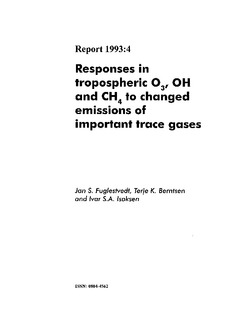Responses in tropospheric O3, OH and CH4 to changed emissions of important trace gases
Research report
Permanent lenke
http://hdl.handle.net/11250/191928Utgivelsesdato
1993Metadata
Vis full innførselSamlinger
- CICERO Reports [210]
Sammendrag
A two-dimensional (altitude vs. latitude) photochemical/transport model of the global troposphere is applied to study the effects of changed emissions of NOx, CH4, CO2 and NMHC on the levels of O3, OH and CH4. On a mass basis, the efficiencies in increasing O3 concentrations differs markedly between the source gases, with NOx having the largest effects. The sensitivity to increased emissions of NOx from airplanes is found to be significantly higher than for ground emissions of NOx (> a factor of 10). The tests also show that the efficiencies are larger for smaller perturbations and that the background levels of NOx are important for the efficiency in O3 enhancement from NOx emissions. Increased emissions of CO2, CH4 and NMHC all reduce tropospheric OH, while increased NOx emissions increase OH. Through changes in OH these source gases also affect the distribution of CH4. Since increased emissions of CH4 reduce the strength of its own main sink, the relative increase in atmospheric levels is larger than the relative increase in emissions. The strength of this positive feedback is estimated to be approximately 35The results indicate that the indirect effects of emissions of CH4, CO2 and NMHC on climate may be positive due to the positive effect on O3 and the negative effect on OH, with the latter effect increasing the lifetimes of greenhouse gases removed by OH. The indirect effects of NOx on climate are of opposite signs; a positive through O3 increases and a negative through OH increases. Thus, estimates of the net effect of the indirect effects of NOx emissions on climate require better knowledge of the NOx distribution and detailed radiative calculations.
